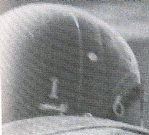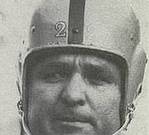Dr. Del Rye,
I noticed on some older, sixties helmets, and on one of your
reproductions from that era, that the helmet decals were very thin,
almost like electrical tape? I was wondering how those decals were made,
or were they in fact, electrical tape put on by the teams' equipment
managers? How are these decals made today? Thank you and continue the
work you have done on this great site.
Dear Alvin:
During most of the 1960s helmet decals were made from a thin mil
vinyl material that had very similar characteristics to conventional
electric tape. The backing on the decals indicated that the material was
manufactured by the 3M Corporation. The vinyl material came in different
colors and the color was imbedded throughout the thickness of the
material. These decals were fabricated using three different methods as
explained below: (1963 NFL and AFL teams that used vinyl helmet decals
are listed by method)
1) Silhouette style decals
Logos were individually die cut from lengths of one color adhesive
backed thin mil vinyl sheets. Examples: Bears / Colts / Cowboys / Giants
/ Lions / Bills / Broncos / Jets / Oilers
2) Silhouette style decals (with
contrasting trim) The primary logo section was
individually cut from lengths of one color adhesive backed thin mil
vinyl sheets. The contrasting trim sections were also individually cut
from lengths of various colored (as needed) adhesive backed thin mil
vinyl sheets. The finished decal was created by overlapping the primary
logo and contrasting trim sections in a pattern dictated by the decal
design. Examples: Packers / Redskins / Chargers
3) Multicolor (detailed) style decals Multiple logos
were ink printed on the exterior surface of a length of white, thin
(almost paper-like), adhesive backed material. The material's exterior
surface was then covered with a thin protective coat of clear shellac.
Finally the multiple logo designs were die cut into individual
decals. Examples: Forty Niners / Steelers / Chiefs / Patriots /
Raiders
In the late 1960s the Brady Corporation developed a new method to
produce decals. The first step consisted of printing (in reverse image)
multiple logo designs on the inside surface of a clear (and thicker mil)
length of vinyl. Step 2 consisted of applying clear adhesive to that
same surface. Finally, a strip of non stick paper backing was applied
over the adhesive and each logo design on the length of vinyl was die
cut into individual decals. The Brady method allowed complex logo
designs to be used without the need to overlap different colored vinyl
pieces or be printed on the vulnerable exterior surface of the decal.

